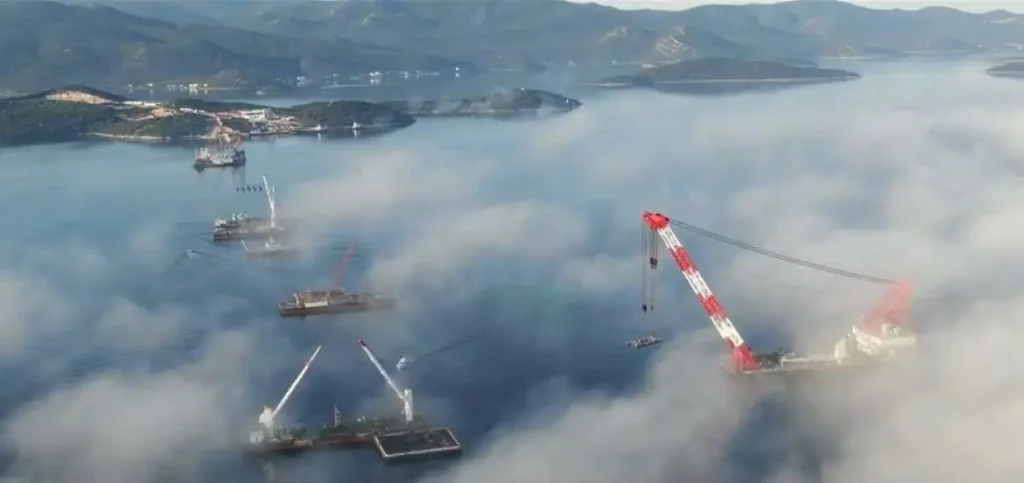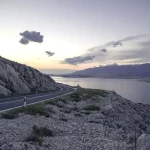As Morski writes, Peljesac bridge with its elegant 2404 metres has surrounded Mali Ston Bay and finally connected Croatian territory. It blends harmoniously into the Dalmatian landscape, but also into a landscape that is not completely safe, either. The bridge is located in an area known for its very frequent seismic activity, where bura and other coastal winds are common and strong. Might a stronger earthquake bring it down, how many gusts of jugo or bura can it withstand, what if a ship crashes into it, and how will its load-bearing capacity and stability be monitored over the years to come?
The answers to these pressing questions came from Croatian roads/Hrvatske ceste, that is, directly from Goran Legac, the engineer who is leading the historic project of the road connection of southern Dalmatia with the rest of the country, as reported by tportal.
His job is to prepare the project, organise, control and supervise all of the participants and their activities and ensure that everything being done is in line with the set plans in terms of deadlines and finances. Simply put, he and his team of experts from various professions, along with the help of numerous surveillance services, are the ones ”hanging” over the heads of the Chinese workers who are building Peljesac Bridge, the Greeks (Avax) and the Austrians (Strabag) whose task is to build all of the accompanying access roads.
”For the quality delivery of the construction work itself, the most important thing is announcing and controlling all of the technical specifications through project documentation that must be completed by the contractor. Conditionally speaking, we perform the project with the same goal, but often with a different approach. The contractor strives to optimise the project in order to earn as much as possible while achieving the required quality. The designer, on the other hand, deals with all the highest standards and norms in order to make the construction as durable as possible. And that’s in the interest of the client, in this case Hrvatske ceste, because of the maintenance costs involved,” explained Legac.
In the case of Peljesac bridge, maintenance costs will be of course by very high. In theory, these costs are calculated by dividing the value of the structure by the expected period of use.
”It’s common to expect that in the projected life of a construction, let’s say we’re talking about a 100-or-so-year period, the construction and equipment of the bridge through regular and extraordinary maintenance will be completely repaired and then replaced. So if the construction cost two billion kuna, then at least that much more will be spent in 100 years on maintenance alone. Of course, these costs will be lower in the beginning, and will increase later in accordance with the contractor’s guarantees,” stated Legac.
What exactly has been done to make sure Peljesac bridge will withstand those 100 years, and hopefully much longer, without shortening its ”shelf life” due to some of the natural disasters such as earthquakes or strong winds Croatia is no stranger to?
Several tectonic faultlines are located very close to the bridge…
Southern Croatia is one of the most seismic areas in the entire country. According to seismologists, the maximum intensity of earthquakes that can hit Dalmatia ranges from 6.3 to 7 degrees on the Richter scale. The fact that there are several faultlines very near to Peljesac bridge isn’t particularly encouraging in this case, which is evident by looking at the scientific database of all European seismic faults.
Legac confirmed all this, but also pointed out that there is no room for fear.
”It’s true that the bridge is located in a zone which has very high levels of seismic activity, with a design ground acceleration at the foundation level of 0.34 g, which is extremely strong. However, the structure is designed and constructed to withstand what earthquakes can cause without collapsing. The level of usability ensures sufficient rigidity so that the bridge can be used even after an earthquake strikes. So, Peljesac bridge can withstand even the strongest earthquakes that can be reasonably expected to strike the area,” assured Legac.
He added huge steel pipes with a diameters of 1.8 metres and two metres, were used to base the pillars in the sea itself. Their length ranges from 36 to 130.9 metres. For comparison, the height of the Zagreb Cathedral is 108 metres. These pipes were driven down firmly into the seabed, with the 130.9-metre one being the world record holder because it is the largest ever to be driven down into one piece, as pipes of these lengths are usually put in in extensions.
In addition to being located in a highly seismic area, the location of Peljesac bridge is known for some extremely strong Dalmatian winds. Will we have the same situation as we unfortunately did with the Maslenica bridge, which closes to traffic when bura or jugo blows?
Legac assured that this will not be the case. Namely, during the design and construction, the problem of local winds was taken into account and the construction of the bridge was tested in an air tunnel, writes tportal.
”The analysis predicts wind gusts of as much as 180 kilometres per hour. From my experience, because I’ve lived near the bridge for about three and a half years now, in Mali Ston Bay the jugo is much more intense than the bura wind is. Along the entire length of the bridge on both sides there will be windbreaks 3.2 which are metres high. You can see similar windbreaks on the Baricevic viaduct on the highway near Sv. Rok. They are a guarantee that the traffic will run smoothly in almost all weather conditions up to a wind speed of 180 kilometres per hour,” Legac pointed out, adding that there are windbreaks on the construction site and they are waiting for installation as well.
The pillars of Peljesac bridge can withstand the impact of a ship of 10 thousand tonnes.
In addition to natural issues such as earthquakes and wind, the design of the bridge had to take into account its navigation profile, which was insisted on by neighbouring Bosnia and Herzegovina, and some Bosnian politicians were known for their negative stance towards the very construction of the bridge. This guarantees extra protection for both vessels and the bridge itself. But what if a large ship crashes into one of the bridge’s pillars? Can he knock it down?
”There are currently no shipping lines in this area. Nonetheless, a waterway passing through the central range is envisaged. Large ships will be able to sail under the bridge. This will prevent large ships from hitting the pillars,” Legac said.
Even if such a situation were to occur, Peljesac bridge’s strong pillars are designed to withstand the impact of a vessel, with those in the middle, between which the waterway passes, being able to fully withstand the impact of a medium-sized ship of 100 metres in length and weighing up to 10,000 tonnes.
Given the strategic importance of Peljesac bridge, the project envisages the installation of equipment for its continuous monitoring. Through it, various parameters will be monitored in real time.
”Concrete isn’t eternal, as some claim it to be. You have the example of the Krk bridge, which has undergone four major reconstructions in 40 years. However, Peljesac bridge is built from concrete that has the most modern additives and is much stronger class than the concrete typically used before. Chemical technology has advanced the most in the field of construction, and all of this is a guarantee that Peljesac bridge will be able to serve us for a very long time to come,” concluded Legac.
For more, make sure to check out our dedicated lifestyle section.











